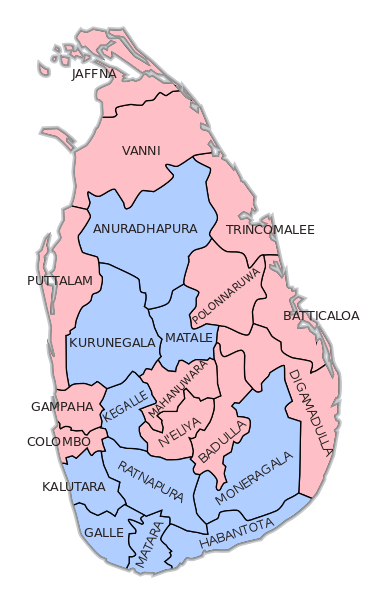Sri Lanka has utilized three electoral systems since independence. The first two electoral systems are differentiated primarily by the increase in the size of Parliament from the first to the second system. In 1989, Sri Lanka ceased using a majoritarian electoral system and switched to a more proportional system.
SRI LANKA 1 (1947-56)
Sri Lanka elected 89 MPs by single-member plurality with an additional 6 MPs appointed by the Governor.
SRI LANKA 2 (1960-77)
In the four elections held from 1960 through 1970, Sri Lanka elected 141 MPs by single-member plurality with an additional 10 MPs elected by the block vote in two constituencies with two MPs and two constituencies with three MPs. Sri Lanka increased the number of MPs to 168 in 1977 with elections held in 160 constituencies. As in the past, most were elected by single-member plurality with relatively few elected by the block vote in multimember constituencies.
SRI LANKA 3 (1989-)
Sri Lanka switched to a new largely proportional electoral system with 196 seats awarded within 22 multimember constituencies (see map below) and 29 allotted using the same votes but within a single national constituency. Voters now have to cast ballots for a single list of a party or coalition but may also cast up to three preference votes. The 22 multimember constituencies correspond to administrative districts except in Northern Province where Jaffna and Killinochchi Districts are combined into a single Jaffna constituency, and Mannar, Mullaittivu and Vavuniya Districts are combined into the Vanni constituency.
In the 22 multimember constituencies, the first seat goes to the list with the most votes. The remaining seats are awarded using the largest remainder system of proportional representation with a Hare quota without regard to which list gained the first seat. Only lists that gain more than 5% of the valid vote qualify to receive seats.
The Hare quota is the number of votes for all qualifying parties divided by the number of seats remaining to be distributed in the constituency (i.e. the total number of seats minus one). Parties first gain seats for full multiples of Hare quotas with any remaining seats given out in descending order of votes not used towards a full Hare quota.
The 29 national seats are distributed based on total across the entire country of the same votes used to award seats within multimember constituencies. The seats are awarded by the largest remainder system with a Hare quota but there is no threshold to qualify for these seats.
Lists are open and voters may cast preference votes for up to three candidates. The order of election within multimember districts is determined entirely by preferences with candidates elected in descending order of preference votes until all seats for a list are filled. However, parties may nominate any candidates from a list submitted prior to the election to fill any national seats that it has won.
Sri Lanka Constituencies
Sources: Constitution of Sri Lanka; Department of Elections; Inter-Parliamentary Union Parline Database; Christian Wagner, “Sri Lanka” in Dieter Nohlen, Florian Grotz and Christof Hartmann, eds., Elections in Asia and the Pacific, Vol. 1 (Oxford 2001), 697-742.


